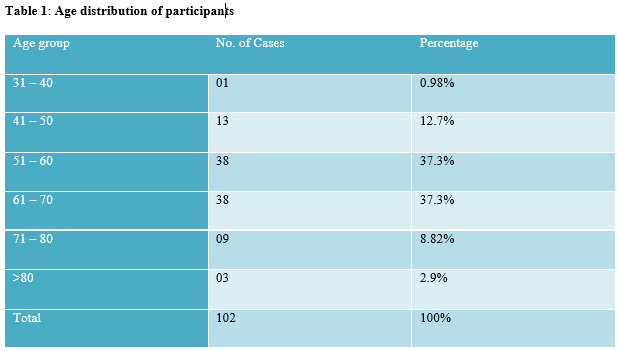Comparison of IOL power & axial length estimated by optical biomicroscopy and ultrasonic biometry.
Abstract
Aim: To compare IOL power & axial length estimated by optical biometry (OB) and ultrasonic biometry (UB).
Material & methods: A prospective & comparative study was planned to compare axial length & IOL power calculated by Appa Scan AME - 01A (Appasamy Associates, India) (UB) & IOL master 500 (Carl Zeiss Meditec, Jena, Germany) (OB). Autokeratometry evaluated using IOL master 500 & SRK/T formula were taken for IOL power estimation. Spss software version 20.0 was used for analysis.
Results: Overall agreement between UB & OB for axial length & IOL power was excellent ( weighted kappa 0.807 & 0.825 respectively).
Conclusion: Ultrasound biometry, a cost-effective method for IOL power & axial length calculation, still holds value as compared to optical biometry for routine cataract surgeries.
Downloads
References
Rao GN, Khanna R, Payal A. The global burden of cataract. Curr Opin Ophthalmol. 2011; 22(1):4-9. doi: 10.1097/ICU.0b013e3283414fc8.
Liu YC, Wilkins M, Kim T, Malyugin B, Mehta JS. Cataracts. Lancet. 2017; 390(10094):600-612. doi: 10.1016/S0140-6736(17)30544-5.
Mohan M. Survey of blindness-India (1986–1989). In: Summary Results: Programme for the Control of Blindness. Ministry of Health and Family Welfare, Government of India: New Delhi; 1992
Dandona L, Dandona R, Srinivas M Giridhar P, Vilas K, Prasad MN, et al. Blindness in the Indian state of Andhra Pradesh. Invest Ophthalmol Vis Sci. 2001;42(5):908-16.
Congdon N, Vingerling JR, Klein BE, et al. Prevalence of cataract and pseudophakia/aphakia among adults in the United States. Arch Ophthalmol. 2004;122(4):487–494. doi: 10.1001/archopht.122.4.487.
Watson A, Armstrong R. Contact or immersion techniques for axial length measurement? Aust NZ J Ophthalmol. 1999; (1):49-51. doi: 10.1046/j.1440-1606.1999.00162.x.
Leaming DV. Practice styles and preferences of ASCRS members: 2003 survey. J Cataract Refract Surg. 2004; 30(4):892-900. doi: 10.1016/j.jcrs.2004.02.064.
Connors R 3rd, Boseman P 3rd, Olson RJ. Accuracy and reproducibility of biometry using partial coherence interferometry. J Cataract Refract Surg. 2002;28(2):235-8. doi: 10.1016/s0886-3350(01)01179-8.
Haigis W, Lege B, Miller N, Schneider B. Comparison of immersion ultrasound biometry and partial coherence interferometry for intraocular lens calculation according to Haigis. Graefes Arch Clin Exp Ophthalmol. 2000; 238(9):765-73. doi: 10.1007/s004170000188.
Narvaez J, Cherwek DH, Stulting RD, et al. Comparing immersion ultrasound with partial coherence interferometry for intraocular lens power calculation. Ophthalmic Surg Lasers Imaging. 2008;39(1):30-4. doi: 10.3928/15428877-20080101-08.
Raymond S, Favilla I, Santamaria L. Comparing ultrasound biometry with partial coherence interferometry for intraocular lens power calculations: a randomized study. Invest Ophthalmol Vis Sci. 2009;50(6):2547-52.
Rajan MS, Keilhorn I, Bell JA. Partial coherence laser interferometry vs conventional ultrasound biometry in intraocular lens power calculations. Eye (Lond). 2002;16(5):552-6.
Montés-Micó R, Carones F, Buttacchio A, Ferrer-Blasco T, Madrid-Costa D. Comparison of immersion ultrasound, partial coherence interferometry, and low coherence reflectometry for ocular biometry in cataract patients. J Refract Surg. 2011;27(9):665-71.

Copyright (c) 2021 Author (s). Published by Siddharth Health Research and Social Welfare Society

This work is licensed under a Creative Commons Attribution 4.0 International License.


 OAI - Open Archives Initiative
OAI - Open Archives Initiative



















 Therapoid
Therapoid

